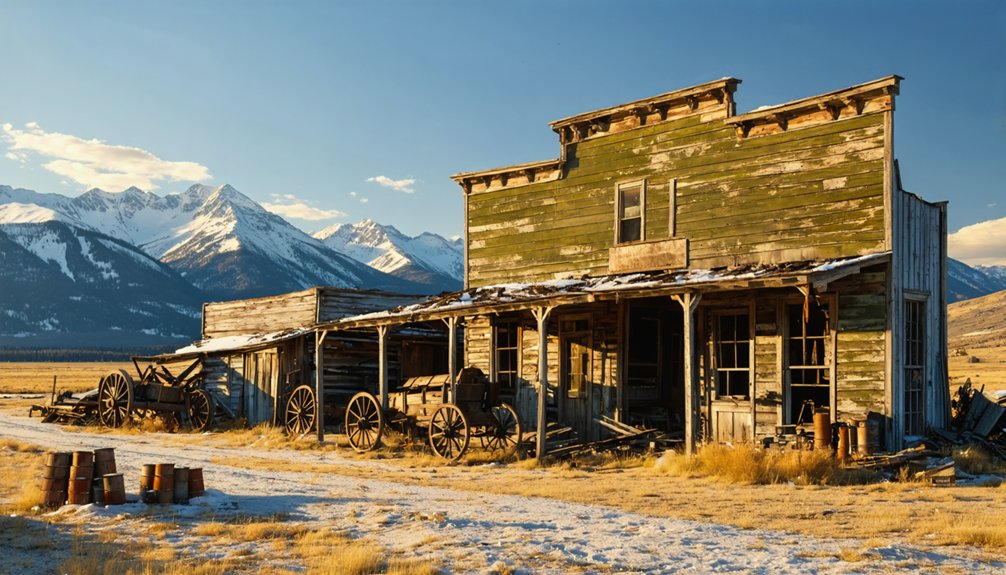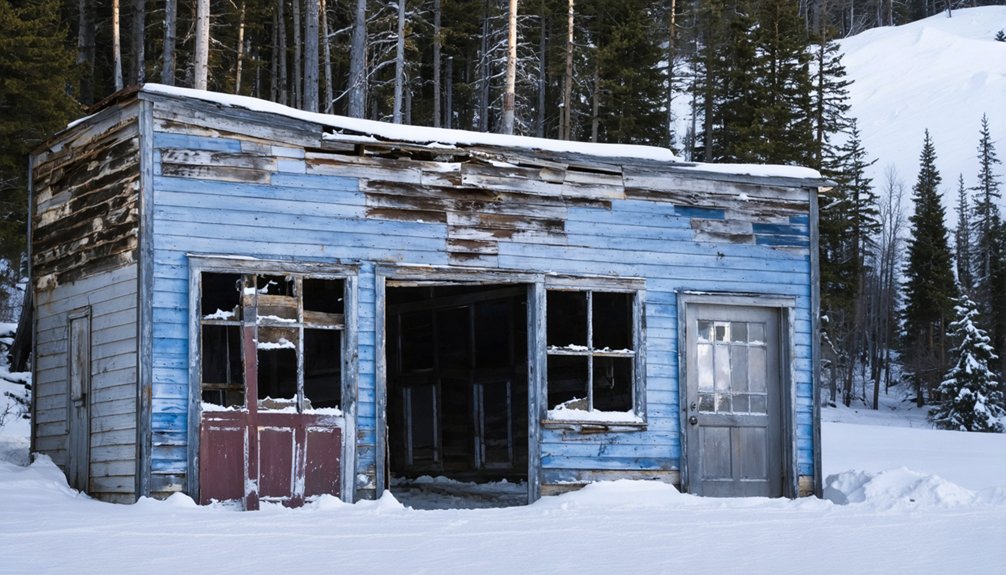You’ll find Centerville, Idaho nestled in the historic Boise Basin, where gold was discovered in 1862 by George Grimes and Moses Splawn. This once-bustling mining camp grew to nearly 3,000 residents by 1863, becoming Idaho’s fourth-largest city. Miners could earn up to $200 daily during its peak, with saloons and boarding houses dotting the landscape. Today, only scattered ruins, two hilltop cemeteries, and the old stage road remain to tell tales of this golden era.
Key Takeaways
- Centerville became a booming gold mining town in 1862 after George Grimes discovered gold, reaching a population of 3,000 by 1863.
- The town featured saloons, a post office, general stores, and mining operations, with Chinese residents significantly contributing to local business.
- Daily gold yields ranged from $8 to $200 per miner, helping Centerville become Idaho’s fourth-largest city during its peak.
- The town declined as gold reserves depleted in the mid-1860s, leading to population loss and economic stagnation.
- Today, only scattered ruins remain, including two hilltop cemeteries and the Twin Sisters Mill ruins across Grimes Creek.
Gold Rush Origins and Early Settlement
When gold was discovered on Boston Bar near present-day Centerville on August 2, 1862, it set off a chain of events that would transform Idaho’s Boise Basin forever.
Prospectors George Grimes and Moses Splawn, guided by indigenous knowledge from a Bannock Indian, unearthed valuable placer mining opportunities along Grimes Creek.
The region’s pine and fir forests provided essential timber resources for building mining camps and equipment.
You can imagine the excitement as thousands of experienced miners from California and Fraser River rushed to stake their claims.
By September 1863, the bustling mining camp had grown to include nearly 3,000 residents, making it one of the largest settlements in the region.
Peak Years of Mining Prosperity
You’ll find that Centerville’s meteoric rise to prominence was fueled by staggering daily gold yields of $8 to $20 for average miners, with some lucky prospectors pulling in up to $200 per day.
The town’s population swelled to nearly 3,000 residents by September 1863, making it the fourth largest city in what would become Idaho.
As miners flooded into the area, Centerville quickly developed into a bustling community, complete with its own post office established in 1864.
The discovery of gold in 1862 by Moses Splawn sparked the initial rush of prospectors to the area.
The diversity of the mining workforce was evident as Chinese miners made up a significant portion of the town’s population, often working in the more challenging terrain and lower-grade deposits.
Daily Gold Production
During the peak years of Centerville’s mining prosperity in the 1860s and 1870s, the town’s daily gold production contributed considerably to the Boise Basin’s impressive 2.3 million ounce total output.
You’d find miners employing various mining techniques, from panning and sluicing to hydraulic methods, to extract precious gold from the rich placer deposits.
While exact daily yields weren’t recorded for Centerville alone, you can gauge the town’s success from its 1879 production value of $200,000, representing thousands of ounces annually.
The area remains significant today, with 16,063 mining claims registered in Boise County through the Bureau of Land Management.
As one of the largest camps in the basin, Centerville’s output rivaled that of Idaho City, where miners extracted over 2 million ounces by the late 1800s.
The daily production varied with seasonal water availability, weather conditions, and the gradual shift from placer to lode mining operations.
Population and Business Growth
As miners flocked to the Boise Basin in 1863, Centerville rapidly emerged as the fourth largest population center in the region, boasting nearly 3,000 residents by that September.
You’d have found a bustling community where saloons, general stores, and assay offices lined the streets, serving a diverse mix of American and foreign-born miners seeking their fortunes.
The town’s population diversity was remarkable, with Chinese immigrants making up a significant portion of the mining workforce.
Chinese residents dominated fresh produce markets and established numerous successful businesses to serve the mining community.
While miners could earn $8 to $20 daily, with some lucky claims yielding up to $200, commercial challenges persisted.
You would’ve faced difficult access routes and occasional tensions with Native groups.
Despite these obstacles, Centerville’s businesses thrived, providing essential services to thousands until the inevitable decline of placer mining in the late 1800s.
Daily Life in a Boomtown
You’d find the social scene in Centerville teeming with activity as miners gathered at saloons and makeshift gathering spots after long days of backbreaking work.
In this bustling boomtown of 3,000 residents, you would’ve witnessed a mix of rough frontier living conditions alongside attempts at civilization, with basic wooden structures serving as homes and businesses. The community celebrated their prosperity with dances and celebrations during the good times. As one of five major communities in the area, Centerville helped contribute to the region’s impressive Boise Basin population of twenty thousand by 1863.
Your daily encounters would’ve included everything from raucous card games and drinking to community meetings at the post office, all while enduring the harsh realities of frontier life in the 1860s Boise Basin.
Mining Camp Social Scene
Life in Centerville’s mining camp revolved around a vibrant but rough-edged social scene, where saloons served as the heart of the community. After exhausting shifts that could earn you $8-$20 a day, you’d find yourself drawn to these lively establishments where gambling, music, and occasional dance halls offered welcome relief from the day’s toil.
The saloon culture perfectly captured Centerville’s complex community dynamics. You’d witness an intriguing mix of characters – courtesans mingling with merchants, priests passing by saloonkeepers, and transient prospectors sharing stories with settled miners. Just like in Quartzburg, where the population reached 30,000 to 40,000 residents during peak mining times, these establishments were always bustling with activity.
In the two-story boarding houses nearby, you’d find communal spaces where residents gathered, adding another layer to the town’s social fabric. While brawls were common and law enforcement was scarce, these social hubs helped forge lasting bonds in this frontier community.
Gold Rush Living Conditions
While seeking fortunes in Centerville’s bustling gold rush, you’d find yourself enduring harsh living conditions that tested even the hardiest souls.
Your shelter conditions would’ve consisted of a hastily built wooden shack or tent, packed tightly among fellow prospectors near the claims. You’d battle the elements through poorly insulated walls and struggle with basic sanitation in the overcrowded settlement. Living alongside you were Chinese mining families, who brought their traditional customs and tools to work abandoned claims.
Daily sustenance brought its own nutrition challenges. You’d subsist mainly on preserved meats, beans, and hardtack, with fresh produce being a rare luxury.
Your long workdays, from dawn until dusk, would leave you exhausted and susceptible to illness, while medical care remained scarce. The local saloons and boarding houses might offer meals, but at steep prices that could quickly drain your mining earnings.
Economic Activities and Commerce
During the height of the Boise Basin gold rush in 1862, Centerville emerged as a significant economic hub, establishing itself as the fourth-largest mining camp in the region with nearly 3,000 residents by September 1863.
The trade dynamics centered primarily around gold extraction, with quartz mining providing long-term stability to the local economy. You’d find a complex network of resource management systems supporting the bustling mining operations.
- Gold and quartz mining dominated the economic landscape
- Trade routes along the Boise River facilitated commerce
- Mining infrastructure supported diverse auxiliary businesses
- Local workforce drove population growth and economic significance
- Economic activities were interconnected with nearby mining camps
While smaller than Idaho City and Placerville, Centerville’s strategic location and mineral wealth made it a crucial contributor to the Boise Basin’s economic prosperity during the mid-19th century.
The Path to Abandonment

As gold reserves steadily depleted in the mid-1860s, Centerville’s once-thriving population of 3,000 began a swift and irreversible decline.
You’ll find the key abandonment factors centered on the town’s inability to diversify beyond mining – as the precious metal dwindled, so did the community’s economic lifeline.
While larger settlements like Idaho City and Placerville managed to sustain themselves, Centerville’s isolation and economic stagnation proved detrimental.
The town’s wooden structures succumbed to harsh mountain winters, and one by one, the saloons, hotels, and livery stables shuttered their doors.
Even the old stage road, once essential for commerce, fell into disuse as transportation routes favored other towns.
Today, only the Protestant and Catholic cemeteries remain, silent sentinels on the hills where a bustling mining town once stood.
Modern Remnants and Historical Impact
Despite Centerville’s once-prominent status as the fourth-largest mining camp in Boise Basin, you’ll find remarkably few remnants of this ghost town today.
Beyond scattered lumber and mine diggings, the site’s most significant archaeological findings center around two hilltop cemeteries – the IOOF and Catholic burial grounds. Cemetery preservation efforts have helped protect these sacred spaces, though the 1931 forest fires damaged many wooden markers.
- Twin Sisters Mill ruins across Grimes Creek offer glimpses of past mining infrastructure
- Original stage road still connects to nearby Placerville, tracing historic transportation routes
- Post office records spanning 1864-1952 document the community’s timeline
- Landscape bears scars of placer mining, typical of Boise Basin gold camps
- Historical societies maintain archives detailing Centerville’s role in Idaho’s mining heritage
Frequently Asked Questions
Were There Any Notable Crimes or Shootouts in Centerville During Its Heyday?
While you’d expect notable shootouts from a Wild West mining town, there aren’t any documented crime statistics or specific violent incidents from Centerville’s heyday, though general lawlessness was likely common.
What Happened to the Twin Sisters Mill After the Town’s Abandonment?
Like scattered bones of a fallen giant, the Twin Sisters Mill crumbled into nothingness. You won’t find any mill restoration efforts – time and nature reclaimed this once-significant industrial site completely.
How Did Severe Winters and Weather Impact Mining Operations in Centerville?
You’d find weather challenges crippled mining productivity, with frozen water halting sluicing, heavy snow blocking site access, and severe cold damaging infrastructure. Labor shortages struck when miners fled harsh winters.
Did Any Famous Historical Figures Ever Visit or Stay in Centerville?
Despite having nearly 3,000 residents by 1863, you won’t find records of any famous visitors to this short-lived boomtown. Unlike Idaho City, which attracted notable figures, Centerville’s historical significance remains tied to mining.
Were There Conflicts Between Native Americans and Centerville Settlers During Mining Operations?
You’ll find few documented direct conflicts between Native Americans and settlers in Centerville, though broader regional tensions existed. The area’s mining operations contributed to displacement and resistance across the Boise Basin territory.
References
- https://www.legendsofamerica.com/idaho-city-idaho/
- https://history.idaho.gov/wp-content/uploads/2018/08/0064.pdf
- http://www.ghosttowngallery.com/htme/idahocity.htm
- https://westernmininghistory.com/towns/idaho/centerville/
- https://history.idaho.gov/wp-content/uploads/2018/12/0166.pdf
- https://www.ghosttowns.com/states/id/centerville.html
- https://visitidaho.org/things-to-do/ghost-towns-mining-history/idaho-city-historical-area/
- https://idahocityhistoricalfoundation.org/?page_id=1126
- https://www.idahogeology.org/pub/Pamphlets/P-131.pdf
- https://www.boisecounty.us/visit-boise-county/



